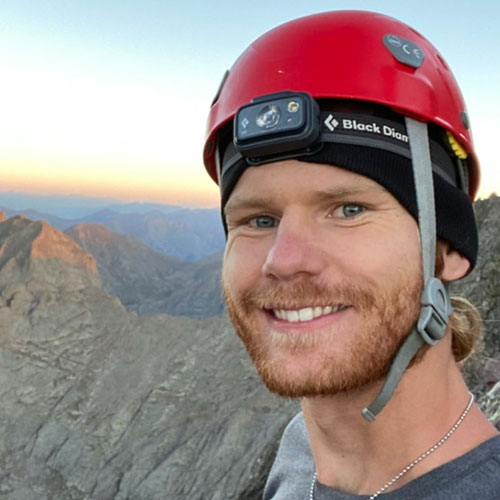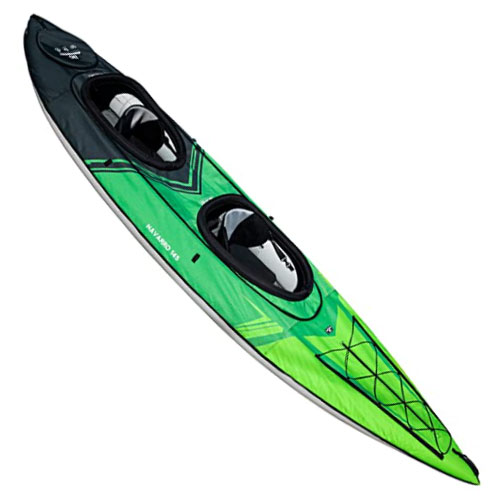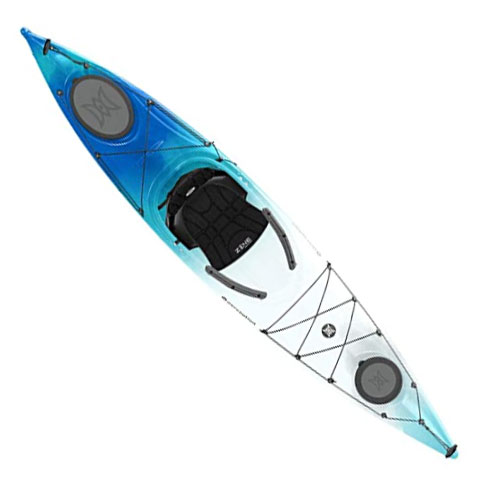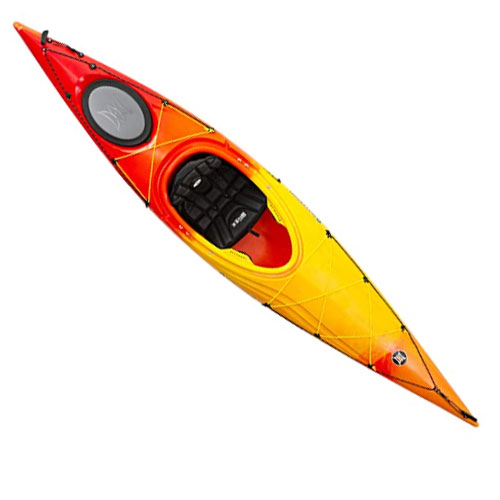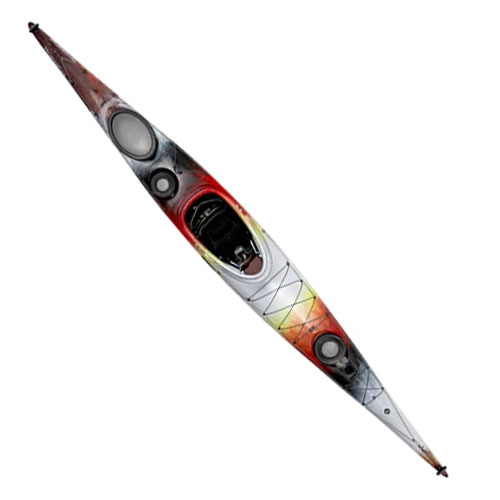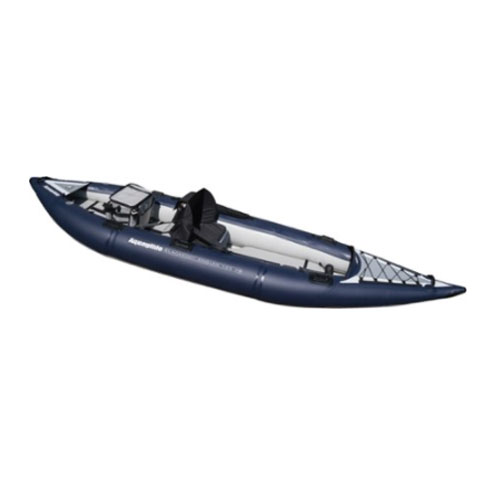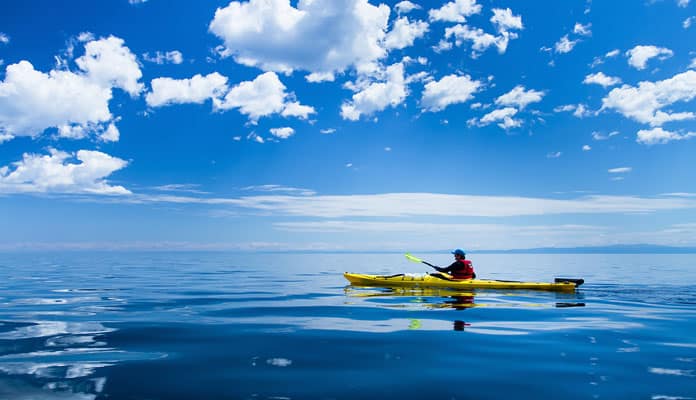
If you enjoy exploring the water and going on multi-day kayaking trips, you need a true touring kayak. Unlike regular models, these kayaks are fast, stable, and comfortable to paddle for several hours at a time. With a touring kayak, you’ll cover large distances with ease and reach your favorite getaway spot much faster.
When choosing a touring kayak, the most important aspects to consider are its length, hull design, and cockpit size. The right combination of these will result in a kayak that is swift, agile, and doesn’t create drag. To help you decide, we’ll take a close look at the best touring kayaks on the market so you can conquer open water with confidence.
OUR TOP PICK
Aquaglide Navarro 145 Convertible Inflatable
- Stand Out Features - Why We Love It
- Convertible deck accommodates 1 to 3 paddlers
- Zippered stern compartment provides dry storage space
- Hex Shell cover for durability and puncture resistance
- Weight capacity allows bringing gear for several days
- Compact packed size makes transportation convenient
Best For: Tandem Touring
Kayak Type: Inflatable
Paddlers: 1 to 3
Length: 14 feet 5 inches
Width: 40 inches
Weight: 40 pounds
Material: Hex Shell, Vinyl
Maximum Capacity: 500 pounds
EDITORS CHOICE
Perception Carolina 12
- Stand Out Features - Why We Love It
- Two large storage hatches for keeping your gear dry
- Soft chines provide excellent primary stability
- Built-in foam bulkheads for additional safety
- V-shaped hull easily cuts through the water
- Compatible with all standard spray skirts
- High weight capacity
Best For: Calm and Coastal Waters
Kayak Type: Sit-In
Paddlers: 1
Length: 12 feet
Width: 26 inches
Weight: 49 pounds
Material: Polyethylene
Maximum Capacity: 275 pounds
BEST VALUE
Perception Expression 11.5
- Stand Out Features - Why We Love It
- Adjustable Zone DLX seat feels fantastic on long rides
- Excellent choice as a first kayak (beginner-friendly)
- TruTrak retractable skeg guarantees great tracking
- Rugged HDPE construction is low-maintenance and impact-resistant
- Quick-adjust footrests provide comfort to both short and tall paddlers
Best For: Long-Distance Comfort
Kayak Type: Sit-In
Paddlers: 1
Length: 11 feet 6 inches
Width: 25.75 inches
Weight: 44 pounds
Material: HDPE (High-Density Polyethylene)
Maximum Capacity: 255 pounds
Wilderness Systems Tempest 165
- Stand Out Features - Why We Love It
- Long and narrow hull provides impressive speed on the water
- TruTrak skeg system for balancing between tracking and maneuverability
- Padded thigh braces make leaning when steering a lot easier
- Bow compass recess allows mounting any standard-sized compass
- Three dry hatches and a bungee-corded deck for packing your gear
Best For: Speed and Tracking
Kayak Type: Sit-In
Paddlers: 1
Length: 16 feet 6 inches
Width: 21.5 inches
Weight: 55 pounds
Material: Polyethylene
Maximum Capacity: 300 pounds
- Stand Out Features - Why We Love It
- Retractable skeg greatly improves tracking
- Drop-stitched Duratex tubes guarantee durability
- Fishing cooler and four rod holders included
- Seven Scotty mounts for installing rod holders
- Backpack travel bag for easier carrying
Best For: Portability and Transportation
Kayak Type: Inflatable
Paddlers: 1
Length: 12 feet 8 inches
Width: 39 inches
Weight: 38 pounds 1.6 ounces
Material: Duratex PVC
Maximum Capacity: 600 pounds
How To Choose A Touring Kayak – Buying Guide
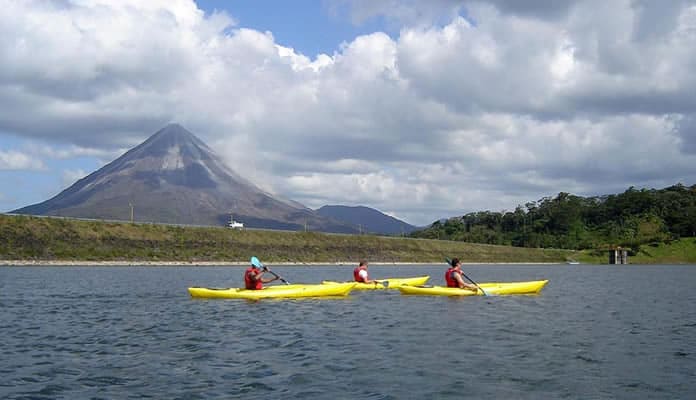
Type Of Adventure
Before picking a kayak for the sea, you’ll want to consider where and how you plan to use it. While many of the top-rated touring kayaks are versatile, there are still differences in design that make them more or less suitable for certain activities.
For example, if you’re mostly going on short single-day trips on your local lake, short and lightweight touring kayaks are the best option. On the other hand, if you plan to go on multi-day kayak camping trips, go for a longer and faster kayak that comes with an abundance of storage.
Skill Level
Your skill level and experience play huge roles when looking for a touring kayak. Owing to their shape and design, most touring models are not particularly beginner-friendly as they don’t have good initial stability and require excellent paddling technique.
This being said, you can enjoy touring as a beginner too. If you’re less experienced, we advise that you go for a kayak that is a bit shorter and has a wider beam so it won’t tip easily (for example the Aquaglide Blackfoot).
Kayak Transportation
Due to their size, kayaks can sometimes be problematic to transport. Unless you get an inflatable that you can set up on the spot, you’ll need a way to get a long kayak down to the water. Because of this, most touring kayaks for the sea require roof racks even if you’re transporting them with a car or truck.
If you don’t like the idea of a roof rack, you can opt for a kayak trailer that will allow you to transport several kayaks at once. In addition, the trailers can usually also carry paddle boards and canoes. However, keep in mind that if there are more than 5 feet of overhang, you’ll need to tape a red flag to the boat.
Skeg Or Rudder (Or Neither)?
If you are serious about kayaking, you’ll want to get a boat that has a skeg or rudder system. Both of these improve the tracking of your boat, but a rudder offers some additional options when it comes to steering.
A skeg is basically a fin that is located on the rear end of the hull. It cuts through the water and helps the kayak stay in a straight line while you’re paddling. Depending on the kayak model, the skeg can be fixed or retractable when you enter the shallow water.
On the other hand, a rudder is more sophisticated – it allows you to turn the boat easier in addition to tracking. Unlike a skeg, you to change its direction while paddling which, in turn, steers the kayak. While some models come with hand-controlled rudders, it’s most convenient if the rudder on your touring sea kayak is controlled by feet.
Shape
Touring kayaks usually feature a long and narrow design that allows them to cut through the water with little resistance. Due to this, they have average initial stability but excel when it comes to secondary stability. In plain English, this means that the kayak won’t be very stable when standing still, but once it gets up to speed the stability increases significantly. If you’re after extra stability, go with a wider kayak.
Storage
Packing anything and everything you need for the weekend requires a lot of space. Luckily, most day touring kayaks usually excel at this and offer all kinds of different storage options. It’s ideal if the kayak has at least two dry storage hatches (bow and stern) so you can keep clothes, food, and sleeping bag protected from the water. On top of this, it’s a bonus if the deck is bungee-corded, as this allows you to secure dry bags if you need extra gear.
Comfort
When touring and going on multi-day adventures, kayak comfort plays an incredibly big role. The comfort mainly depends on the cockpit size, seating system, and whether the model has foot braces. We suggest that you get a cockpit that fits your body frame well and comes with a padded seat and adjustable foot braces.
Since we feel comfort is very important for this type of kayaking, all the models we picked for our touring kayak reviews are excellent for long-distance paddling.
Seat
Because paddling sessions can be very long when touring, a comfortable and adjustable seat is paramount in a day touring kayak. The best touring kayaks should have highly-adjustable seats that will allow you to find the perfect position when you get out on the water. If you have the opportunity, we suggest sitting in the kayak and trying it out before purchase to see how you feel in the seat and whether it suits you.
Cockpit Design
For optimal comfort and performance, you want a kayak for the sea that fits your body size. The opening should be large enough to allow you to get in and out easily, while the cockpit itself should be snug.
Less space around you means that you’ll have more control over the kayak, which is very important in choppy water. On the other hand, sit on top touring kayaks enough space to position your legs comfortably.
Material
Kayak materials impact its performance, portability, and durability. Saying outright which material is best is difficult, so we’ll tell you a few words about each of them.
Polyethylene is one of the most commonly used materials for touring kayaks. It’s durable, flexible, and very affordable. However, it’s prone to warping and damage if stored outside.
Polycarbonate is a great alternative. These touring kayaks have a glossy finish while being more scratch-resistant than polyethylene boats. They are still very affordable and also easier to repair.
Fiberglass is known for its low weight, so it’s a great choice if you’re looking for portability. While it’s not as durable when it comes to scratches and dings, it’s pretty easy to repair so this won’t be a big problem.
Kevlar is found in some of the best touring kayaks, but it comes at a price. It’s almost as strong as steel and won’t be affected by dragging on rocks or sand like the other materials. However, it’s hard to repair if it gets damaged.
You might also like:
FAQs
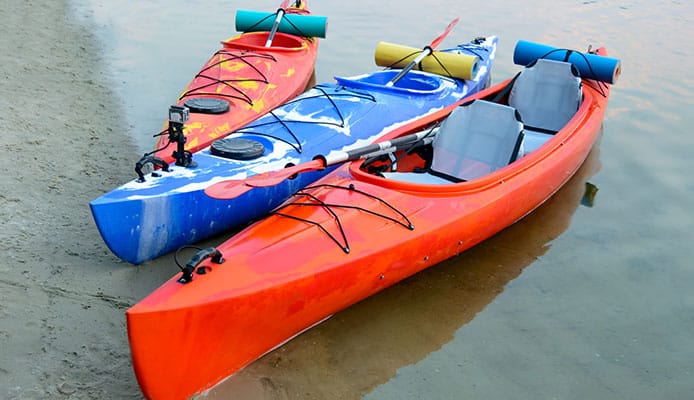
Q: What Is The Difference Between A Touring Kayak And A Sea Kayak?
The differences between the two are not very significant, and they were even in the same category for a long time. A sea kayak, like the name implies, is designed for use on the sea. This means that it has a spray skirt to keep the cockpit dry, and offers more secondary stability so you don’t tip over when hit by waves. Touring kayaks share many of the same qualities, but are usually narrower and faster on the open water.
Q: How Big Should My Touring Kayak Be For Women?
In general, touring kayaks will range in length from 10 to 16 feet. Due to their smaller body frame, women should look for a kayak in the 10 to 13 feet range. This will provide more than enough storage and comfort while being much easier to control than the longer versions.
Q: What Size Kayak Paddle Should You Get For A Touring Kayak?
The paddle size depends on your own height and boat width, but it’s generally accepted that shorter paddles are better for touring kayaks because they cause less fatigue. In addition, the paddles should be as light as possible so they won’t strain your arms on multi-hour sessions.
Q: How To Put Touring Kayak In A Full-Size Truck?
Kayaks designed for touring are 10 to 16 feet long, while truck beds usually measure around 6 feet. This means that if you place it on the truck bed you’ll have a significant overhang with both open and closed gate, which is not ideal for transportation.
The best option is getting roof racks specifically designed for trucks that will extend the roofline of the cab. This will allow your kayak to sit above the cab and the bed of your truck, reducing the amount of overhang you have.
Q: What Are The Average Miles Per Hour When Kayak Touring?
This can vary greatly depending on the person's paddling and the pace they want to keep. This being said, the average recreational paddler will travel around 3-4 miles per hour. On the other hand, you can get up to 7-9 mph if you are racing. Just keep in mind that variables like wind and water conditions also affect your speed.
Q: How To Balance A Touring Kayak?
The balance of your kayak has a huge impact on the boat’s performance and stability. Since you’ll be sitting in the middle, the most important thing is how you’ll distribute your gear. Most sea kayaks have storage areas at both ends, so try to keep the weight on bow and stern as even as possible for optimal performance.
Q: What Are Rudders For On A Touring Kayak?
A rudder system will ensure that the kayak stays in a straight line when paddling. In addition, it also helps with steering, and improves how the kayak handles choppy water.
Globo Surf Overview
Kayak touring is one of the best ways to explore and enjoy the open water. With the right kayak, you’ll cover large distances with ease and get the most of what kayaking can offer. We hope that our touring kayak reviews and guide have helped you choose the best kayak for touring that will be your reliable partner on the water for years to come.


